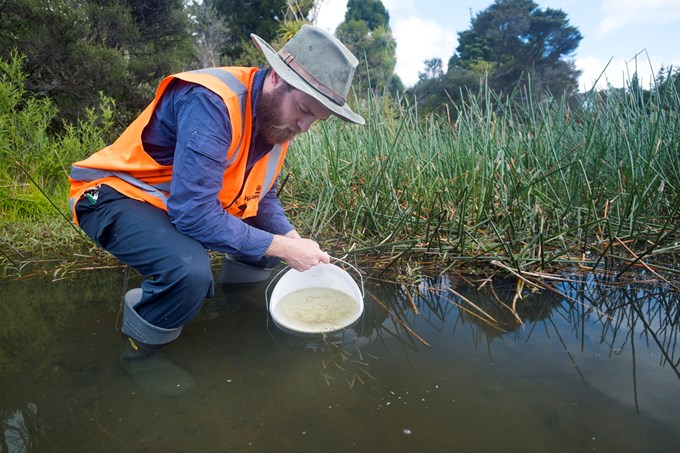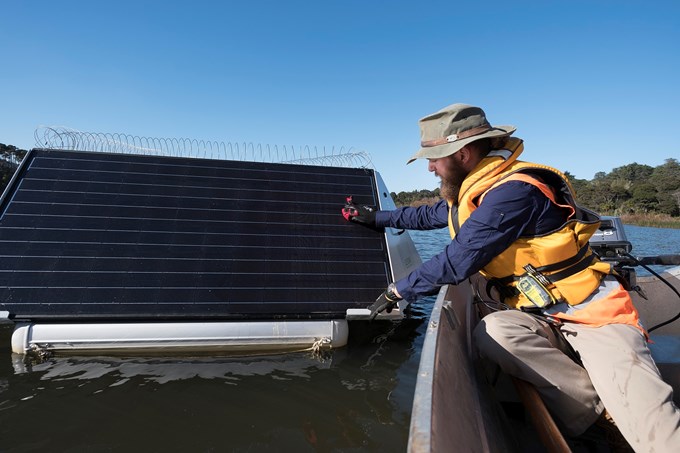Music videos, TV shoots, assisting migrating fish, maintaining water quality, dams, pipes and valves – all of the above could be in a day’s work for Watercare Dam Technician Gareth Whittington.
“The dam technician’s role is really diverse,” says Gareth.
“There is a lot that the public doesn’t see – all the parts that make the system work need constant maintenance.”
When his role doesn’t require assisting Kiwi musicians on video shoots or facilitating scenes for Power Rangers at Waitakere Dam, Gareth looks after the infrastructure that keeps Auckland’s water stored safely.
“Dam technicians and the Environmental Assets team are also responsible for water quality tasks related to the reservoirs, both upstream and downstream,” he says.
The catchment area is part of this responsibility. Gareth and the Watercare team advocate that no herbicides or chemicals are used within the catchment and monitor this to keep the fresh water uncontaminated.
“The trees and vegetation in the Waitakere and Hunua Ranges are part of what makes New Zealand iconic around the world,” says Gareth.
“It still needs maintenance, so we make sure this is taken care of by watching for anything that may overgrow or slip into the water. Slips or loose debris floating in the reservoir can have an impact on the treatment process down the line.”
"Water clarity, biological and algal content, and temperature all play their part in the quality of water," explains Gareth.
“Dam technicians look after the aeration lines that mix the water in the reservoir to make sure the water contents and quality varies from top to bottom.”
This is done by releasing compressed air at the bottom of the dam, the bubbles rise to the top causing a mixing current. At Upper Huia and Upper Nihotupu, diesel generators run the air compressors as there is no mains power at these more remote sites.

“We also maintain turbidity meters to measure the ‘dirtiness’ of the water being piped to the water treatment plants – which gives an idea of how much suspended solids are in there,” says Gareth.
“These require regular cleaning and calibration. We also do weekly lake condition reports to track water quality.”
To ensure the downstream water quality and environment are not negatively affected, water is regularly flushed through the pipework system through the dam to the downstream waterways, simulating the stream’s natural flow. Staff have to be on-site to open the valves, record times, lake levels and turbidity of the stream, both before and after flushing.
As part of the responsibility of running our water-supply dams, there are also fishing programmes. The dams can be hard to traverse for our native migrating fish, so Gareth and the Watercare team give them a hand by collecting īnanga (whitebait) and juvenile tuna (eel elvers) and bring them from the sea to the reservoir. Similarly, when it comes time for adult eels to migrate out, they are transferred in the other direction.
For dam enthusiasts or an out-of-the-ordinary outing, the public are welcome to visit the Lower Nihotupu Reservoir in Huia.
“We have a fairly unique system there: an ultrasonic algae control system. There is a series of five buoys floating on the reservoir, these are solar powered and use ultrasonic waves emitted into the water to destroy algal cells, and keep the water clean and clear,” explains Gareth.
“We take our small boat out for regular maintenance runs – not a bad day at work!”
About Watercare
Watercare is dedicated to providing the people of Auckland with a water supply that is safe, reliable and sustainable, and wastewater services that are efficient and effective.
Watercare delivers A-grade water to 1.5 million customers every day – and they’re upgrading and extending core water and wastewater infrastructure to make sure they can keep up with Auckland’s growth.
Clean, healthy water is essential to our future. As our region continues to grow and change, we need to look after this precious taonga. Visit akhaveyoursay.nz to have your say on how we should waterproof our future. Feedback is open until 19 April.
Read more about the Our Water Future: Auckland's water discussion on OurAuckland.


